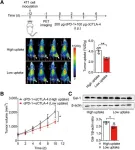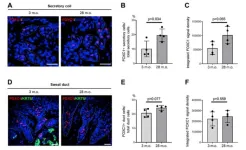(Press-News.org) Guideline Highlights:
The new joint guideline from the American Heart Association and the American College of Cardiology provides recommendations to guide clinicians in the treatment of patients with lower extremity peripheral artery disease (PAD) and supports broad implementation of the PAD National Action Plan – an outline of six strategic goals to improve awareness, detection and treatment of PAD nationwide.
The guideline urges clinicians to be aware of the signs and symptoms of PAD in its four clinical presentations (asymptomatic, chronic symptomatic PAD, chronic limb-threatening ischemia (CLTI) and acute limb ischemia (ALI)) and to recognize the role other factors, such as health disparities and social determinants of health, may play in the development and progression of the disease, including an increased risk of major adverse cardiovascular events and amputation.
Implementation of a multispecialty care team approach, including expertise in risk factor management, guideline directed medical therapies, wound and foot care and endovascular and surgical revascularization procedures, may improve outcomes for people with PAD.
The guideline was developed with and endorsed by the American Association of Cardiovascular and Pulmonary Rehabilitation, the American Podiatric Medical Association, the Association of Black Cardiologists, the Society for Cardiovascular Angiography and Interventions, the Society for Vascular Medicine, the Society for Vascular Nursing, the Society for Vascular Surgery, the Society of Interventional Radiology and the Vascular & Endovascular Surgery Society.
Embargoed until 1:00 p.m. CT / 2:00 p.m. ET Tuesday, May 14, 2024
DALLAS and WASHINGTON, May 14, 2024 — Timely diagnosis and proper management of peripheral artery disease (PAD), including coordinated care from a multispecialty team, are essential to help prevent amputation and other cardiovascular complications and to allow patients with PAD to live longer lives with better physical function and improved quality of life, according to a new joint guideline published today in the American Heart Association’s flagship, peer-reviewed journal Circulation and simultaneously in the Journal of the American College of Cardiology.
The “2024 AHA/ACC Guideline on the Management of Lower Extremity Peripheral Artery Disease: A Report of the American College of Cardiology/American Heart Association Joint Committee on Clinical Practice Guidelines” provides the latest, evidence-based recommendations to guide clinicians in the diagnosis and treatment of lower extremity PAD across its four clinical presentation subsets: asymptomatic disease, chronic symptomatic PAD, and the more severe subsets of chronic limb-threatening ischemia (CLTI) and acute limb ischemia (ALI).
In addition to being led by the American Heart Association and the American College of Cardiology Joint Committee on Clinical Practice Guidelines, the guideline was developed with and endorsed by the American Association of Cardiovascular and Pulmonary Rehabilitation, the American Podiatric Medical Association, the Association of Black Cardiologists, the Society for Cardiovascular Angiography and Interventions, the Society for Vascular Medicine, the Society for Vascular Nursing, the Society for Vascular Surgery, the Society of Interventional Radiology and the Vascular & Endovascular Surgery Society.
PAD is a serious, progressive cardiovascular disease primarily caused by a buildup of fatty plaque in the blood vessels, or atherosclerosis. This plaque narrows the blood vessels and reduces blood flow to the legs and feet, which may significantly impair physical function, walking performance and quality of life. Approximately 10 million to 12 million adults ages 40 and older in the U.S. have PAD, which increases the risk of amputation, heart attack, stroke and death. Among those ages 65 and older, nearly 50% who underwent limb amputation died within one year after surgery, according to the 2024 Heart Disease and Stroke Statistics: A Report of U.S. and Global Data From the American Heart Association. Risk factors for PAD include smoking; having Type 1 or Type 2 diabetes, high blood pressure, high cholesterol, chronic kidney disease, atherosclerosis in other parts of the body (such as coronary artery disease); and being age 75 years or older.
Effective medical therapies and coordinated care
Once PAD is diagnosed, implementing a plan of care, including guideline-directed medical therapies and management of PAD-related risk amplifiers, is crucial to reduce the risk of progression to more symptomatic and limb-threatening clinical presentations of PAD and to reduce the risk of amputation, heart attack, stroke and death. Although there are highly effective medical, endovascular and surgical therapies for PAD, historically, many people with PAD have been undertreated or do not receive guideline-directed medical therapies at the same rate as peers with other cardiovascular diseases, such as coronary artery disease.
“Because of the complexities of PAD, to improve outcomes and reduce the risk of limb loss for these patients, a multispecialty care team approach that is focused on comprehensively addressing risk factor management, foot care and revascularization is needed to promote collaboration, avoid duplication of care and optimize patient outcomes,” said Chair of the guideline writing committee Heather Gornik, M.D., FAHA, co-director of the Vascular Center at the University Hospitals Harrington Heart & Vascular Institute and a professor of medicine at Case Western Reserve University School of Medicine, both in Cleveland, Ohio.
Effective medical therapies for patients with PAD, including medications to prevent blood clotting, manage blood sugar and reduce high blood pressure and high cholesterol, should be prescribed to prevent major adverse cardiovascular events and reduce the risk of amputation. All patients with PAD should be treated with high-intensity statin therapy. For people with PAD who are not at an increased risk of bleeding, new evidence supports the use of low-dose rivaroxaban (2.5 mg twice daily) combined with low-dose aspirin (81 mg daily).
For patients with PAD and Type 1 or Type 2 diabetes, clinicians should coordinate care to address diet, exercise, weight management, medications to control blood sugar, management of other cardiovascular risk factors and routinely check the feet of their patients for foot ulcer prevention. Foot care is important for patients across the four clinical presentation subsets of PAD. Comprehensive treatment includes patient education, preventive foot care, more intensive wound care and pressure off-loading to minimize amputation in patients with more severe forms of PAD.
Health care professionals should also encourage patients to quit smoking or using other forms of tobacco to reduce the risk of developing PAD, to slow the progression of established PAD and to reduce the risk of limb-related conditions or death. Pharmacological and behavioral-based strategies often increase the smoking cessation rate in people with PAD, however, these strategies are underused.
A core component of care for patients with symptomatic PAD is structured exercise therapy programs, including both community- and home-based programs, as well as supervised exercise therapy delivered in a clinic or hospital setting. Multiple studies have shown that these programs improve functional status, walking performance and quality of life compared to usual care.
“Supervised exercise therapy, the gold standard exercise therapy for patients with PAD, is woefully underutilized despite its known health benefits and the fact that it is covered by Medicare and most health insurance plans,” said Gornik. “Rates of referral for supervised exercise therapy among PAD patients are incredibly low. It has been estimated that less than 5% of patients with PAD in the U.S. are prescribed to participate in a supervised exercise program.”
If left untreated, PAD may progress to severe forms known as chronic limb-threatening ischemia (CLTI) and acute limb ischemia (ALI). Both are the result of severe blockage in the arteries of the legs that significantly reduces blood flow, causes pain in the legs at rest or with minimal activity, impairs physical function and significantly increases the risk of amputation and death. For these patients, timely diagnosis and treatments, including revascularization procedures to reconstruct diseased arteries, are essential to prevent tissue loss and preserve the limb. Endovascular (a catheter procedure), surgical or hybrid revascularization techniques may be performed to improve blood flow to the limb, with the goals of healing wounds, relieving PAD-associated pain, maintaining walking ability and preventing amputation.
Disparities in risk factors for PAD and health outcomes
The disparities in PAD care and outcomes are significant among people from under-resourced communities in the U.S. Black adults have a nearly 30% lifetime risk of developing PAD compared to 19% for white adults. Black adults with PAD in the U.S. are often identified at a more advanced stage and have a four-fold higher rate of major limb amputation, 30% higher heart disease mortality rate and 45% higher rate of stroke compared to white adults.
Social determinants of health, and other factors such as race and ethnicity, disparities in housing, health care access, education and socioeconomic status, may also affect the prevalence of PAD and patient outcomes.
“Racial and ethnic disparities in the detection, management and health outcomes of PAD have long been present in the U.S. and are an important public health issue to be addressed,” said Gornik. “These disparities highlight opportunities for initiatives focused on early disease detection and improving access to effective PAD treatments for people in under-resourced, at-risk communities.”
Detection of PAD in most patients is accomplished through a thorough medical history, physical examination and resting ankle-brachial index (ABI), which measures the ratio of the systolic blood pressure at the ankle to the upper arm. The guideline recommends patient-centered efforts to address health disparities, such as intensified efforts to identify patients in at-risk populations for symptoms and signs of PAD, and equitable access to regular physical examinations including thorough assessment of the legs and feet.
Get with The Guidelines: The PAD National Action Plan
In 2021, the American Heart Association published the PAD National Action Plan, which is endorsed by the American College of Cardiology, that outlines six strategic goals to improve awareness, detection and treatment of PAD nationwide. In the plan, the Association proposed a goal of reducing nontraumatic limb amputation in the U.S. by 20% by 2030.
The guideline writing committee notes that interventions are needed to address the disparity gap in amputation and revascularization procedures among people in diverse racial and ethnic populations and to improve limb and cardiovascular outcomes for all patients with PAD.
“It’s important to recognize the signs and symptoms of PAD and move quickly to initiate treatment to improve outcomes and reduce risks,” said Gornik. “With these updated guidelines, we have the tools necessary to make a positive impact on outcomes in our patients with PAD. Now, we need to work together to implement them as broadly as possible.”
This joint guideline was prepared by a volunteer writing group on behalf of the American Heart Association/American College of Cardiology Joint Committee on Clinical Practice Guidelines, and developed with and endorsed by the American Association of Cardiovascular and Pulmonary Rehabilitation, the American Podiatric Medical Association, the Association of Black Cardiologists, the Society for Cardiovascular Angiography and Interventions, the Society for Vascular Medicine, the Society for Vascular Nursing, the Society for Vascular Surgery, the Society of Interventional Radiology, and the Vascular & Endovascular Surgery Society. This joint guideline provides the official clinical practice recommendations for the diagnosis and treatment of peripheral artery disease, or PAD.
Co-authors are Co-Vice Chairs Herbert D. Aronow, M.D., M.P.H., and Philip P. Goodney, M.D., M.S.; Shipra Arya, M.D.; Esther S.H. Kim, M.D., M.P.H., FAHA; Luke Packard Brewster, M.D., Ph.D., FAHA; Scott Kinlay, M.B.B.S., Ph.D., FAHA; Lori Byrd, M.S.; Lee Kirksey, M.D.; Venita Chandra, M.D.; Debra Kohlman-Trigoboff, R.N., M.S.; Douglas E. Drachman, M.D.; Chandler A. Long, M.D.; Jennifer M. Eaves, D.N.P., R.N.; Amy West Pollak, M.D., M.Sc., FAHA; Jonathan K. Ehrman, Ph.D., FAHA; Saher S. Sabri, M.D.; John N. Evans, D.P.M.; Lawrence B. Sadwin; Thomas S.D. Getchius; Eric A. Secemsky, M.D., M.Sc., FAHA; J. Antonio Gutiérrez, M.D., M.H.S.; Maya Serhal, M.D.; Beau M. Hawkins, M.D.; Mehdi H. Shishehbor, D.O., M.P.H., Ph.D.; Connie N. Hess, M.D., M.H.Sc., FAHA; Diane Treat-Jacobson, Ph.D., R.N., FAHA; Karen J. Ho, M.D., FAHA; and Luke R. Wilkins, M.D. Authors’ disclosures are listed in the manuscript.
The American Heart Association receives funding primarily from individuals. Foundations and corporations (including pharmaceutical, device manufacturers and other companies) also make donations and fund specific Association programs and events. The Association has strict policies to prevent these relationships from influencing the science content. Revenues from pharmaceutical and biotech companies, device manufacturers and health insurance providers, and the Association’s overall financial information are available here.
The “2024 AHA/ACC Guideline on the Management of Lower Extremity Peripheral Artery Disease” publishes simultaneously today in the American Heart Association’s flagship journal, Circulation, and the American College of Cardiology’s flagship journal, Journal of the American College of Cardiology.
Additional Resources:
Available multimedia is on right column of release link https://newsroom.heart.org/news/early-diagnosis-treatment-of-peripheral-artery-disease-essential-to-improve-outcomes-reduce-amputation-risk?preview=a64b12c64c96563e88b82468dcd49a2b
Spanish news release (to be added to release link)
After May 14, access the joint guideline online in Circulation and JACC.
AHA health information: What is Peripheral Artery Disease?
AHA health resources: PAD National Action Plan
AHA News story: Routine Tests May Reduce Disparities in Peripheral Artery Disease and Amputation Risk (June 2023)
AHA news release: Symptoms, Quality of Life Important to Guide Treatment for Peripheral Artery Disease (PAD) (Oct. 2022)
AHA Science News article: Reducing Nontraumatic Lower-Extremity Amputations By 20% By 2030: Time to Get to Our Feet (March 2021)
Follow AHA/ASA news on X @HeartNews
JACC.org Guideline Hub (after embargo – 2 p.m. ET, May 14, 2024)
2024 Lower Extremity Peripheral Artery Disease Guideline-at-a-Glance (after embargo – 2 p.m. ET, May 14, 2024)
###
About the American Heart Association
The American Heart Association is a relentless force for a world of longer, healthier lives. We are dedicated to ensuring equitable health in all communities. Through collaboration with numerous organizations, and powered by millions of volunteers, we fund innovative research, advocate for the public’s health and share lifesaving resources. The Dallas-based organization has been a leading source of health information for a century. During 2024 - our Centennial year - we celebrate our rich 100-year history and accomplishments. As we forge ahead into our second century of bold discovery and impact, our vision is to advance health and hope for everyone, everywhere. Connect with us on heart.org, Facebook, X or by calling 1-800-AHA-USA1.
About the American College of Cardiology
The American College of Cardiology (ACC) is the global leader in transforming cardiovascular care and improving heart health for all. As the preeminent source of professional medical education for the entire cardiovascular care team since 1949, ACC credentials cardiovascular professionals in over 140 countries who meet stringent qualifications and leads in the formation of health policy, standards and guidelines. Through its world-renowned family of JACC Journals, NCDR registries, ACC Accreditation Services, global network of Member Sections, CardioSmart patient resources and more, the College is committed to ensuring a world where science, knowledge and innovation optimize patient care and outcomes. Learn more at www.ACC.org or follow @ACCinTouch.
END
Early diagnosis & treatment of peripheral artery disease essential to improve outcomes, reduce amputation risk
Coordinated care among multispecialty team may reduce risk of amputation, heart attack, stroke and death for people with PAD, according to new joint guideline from the American Heart Association, the American College of Cardiology and nine other medical s
2024-05-14
ELSE PRESS RELEASES FROM THIS DATE:
Innovative USask 'mini-brains' could revolutionize Alzheimer’s treatment
2024-05-14
SASKATOON--Using an innovative new method, a University of Saskatchewan (USask) researcher is building tiny pseudo-organs from stem cells to help diagnose and treat Alzheimer’s.
When Dr. Tyler Wenzel (PhD) first came up with the idea of building a miniature brain from stem cells, he never could have predicted how well his creations would work.
Now, Wenzel’s “mini-brain” could revolutionize the way Alzheimer’s and other brain-related diseases are diagnosed and treated.
“Never in our wildest dreams did we think that our crazy idea would work,” ...
$1 million grant project tackles economic, marketing gaps in US aquaculture
2024-05-14
MEDIA INQUIRES
Laura Muntean
laura.muntean@ag.tamu.edu
601-248-1891
FOR ...
MIT researchers discover the universe’s oldest stars in our own galactic backyard
2024-05-14
MIT researchers, including several undergraduate students, have discovered three of the oldest stars in the universe, and they happen to live in our own galactic neighborhood.
The team spotted the stars in the Milky Way’s “halo” — the cloud of stars that envelopes the entire main galactic disk. Based on the team’s analysis, the three stars formed between 12 and 13 billion years ago, the time when the very first galaxies were taking shape.
The researchers have coined the stars ...
How to ensure biodiversity data are FAIR, linked, open and future-proof? Policy makers and research funders receive expert recommendations from the BiCIKL project
2024-05-14
Within the Biodiversity Community Integrated Knowledge Library (BiCIKL) project, 14 European institutions from ten countries, spent the last three years elaborating on services and high-tech digital tools, in order to improve the findability, accessibility, interoperability and reusability (FAIR-ness) of various types of data about the world’s biodiversity. These types of data include peer-reviewed scientific literature, occurrence records, natural history collections, DNA data and more.
By ensuring all those data are readily available and efficiently interlinked to each other, the project consortium’s intention is to provide better tools to the scientific community, ...
Lessons in chemistry: Guo aims at fundamental understanding of emerging semiconductor material
2024-05-14
Metal halide perovskites have emerged in recent years as a low-cost, highly efficient semiconducting material for solar energy, solid-state lighting and more. Despite their growing use, a fundamental understanding of the origins of their outstanding properties is still lacking. A Husker scientist is aiming to find answers that could lead to the development of new materials and new applications.
Yinsheng Guo, assistant professor of chemistry at the University of Nebraska–Lincoln, also wants to transform how physical chemistry is taught to undergraduate and graduate students, who often struggle to understand and apply what ...
Newly identified PET biomarker predicts success of immune checkpoint blockade therapy
2024-05-14
Reston, VA—The protein galectin-1 (Gal-1) has been identified as a new PET imaging biomarker for immune checkpoint blockade (ICB) therapy, allowing physicians to predict the tumor responses before beginning treatment. Information garnered from Gal-1 PET imaging could also be used to facilitate patient stratification and optimize immunotherapy, enabling targeted interventions and improving patient outcomes. This research was published in the May issue of The Journal of Nuclear Medicine.
Immunotherapies, such as ICB, have produced promising clinical ...
Age-associated gene expression changes in mouse sweat glands
2024-05-14
“In this study, we first obtained evidence that, in mouse, aging primarily reduced the number of active sweat glands.”
BUFFALO, NY- May 14, 2024 – A new research paper was published in Aging (listed by MEDLINE/PubMed as "Aging (Albany NY)" and "Aging-US" by Web of Science) Volume 16, Issue 8, entitled, “Characterization of age-associated gene expression changes in mouse sweat glands.”
Evaporation of sweat on the skin surface is the major mechanism for dissipating heat in humans. The secretory capacity of sweat glands (SWGs) ...
26-year-old heart transplant and stroke survivor named national champion for women’s health
2024-05-14
DALLAS, May 13, 2024 — Fewer than half of all women are aware that heart disease is their leading cause of death. That is why the American Heart Association, celebrating one hundred years of lifesaving service, created its community-based Woman of Impact™ initiative as an outgrowth of its year-round Go Red for Women® activist movement. The movement spotlights the lack of awareness and the clinical care gaps in women’s heart health. This year’s National Winner of the Go Red for Women 2024 Woman of Impart initiative is a 26-year-old heart transplant recipient, stroke survivor and American Heart Association local volunteer, Hana Hooper from Puget ...
Virus that causes COVID-19 can penetrate blood-retinal-barrier and could damage vision
2024-05-14
The blood-retinal barrier is designed to protect our vision from infections by preventing microbial pathogens from reaching the retina where they could trigger an inflammatory response with potential vision loss. But researchers at the University of Missouri School of Medicine have discovered the virus that causes COVID-19 can breach this protective retinal barrier with potential long-term consequences in the eye.
Pawan Kumar Singh, PhD, an assistant professor of ophthalmology, leads a team researching new ways to prevent and treat ocular infectious diseases. Using a humanized ...
Stem cells provide new insight into genetic pathway of childhood cancer
2024-05-14
Scientists have discovered a new insight into the genetic pathway of childhood cancer, offering new hope for tailored treatments.
Researchers from the University of Sheffield have created a stem cell model designed to investigate the origins of neuroblastoma, a cancer primarily affecting babies and young children.
Neuroblastoma is the most common childhood tumour occurring outside the brain, affecting the lives of approximately 600 children in the European Union and the United Kingdom each year.
Until now, studying genetic changes and their role in neuroblastoma initiation has been challenging due to the lack of suitable laboratory ...
LAST 30 PRESS RELEASES:
University of Oklahoma researcher awarded funding to pursue AI-powered material design
Exploring how the visual system recovers following injury
Support for parents with infants at pediatric check-ups leads to better reading and math skills in elementary school
Kids’ behavioral health is a growing share of family health costs
Day & night: Cancer disrupts the brain’s natural rhythm
COVID-19 vaccination significantly reduces risk to pregnant women and baby
The role of vaccination in maternal and perinatal outcomes associated with COVID-19 in pregnancy
Mayo Clinic smartwatch system helps parents shorten and defuse children's severe tantrums early
Behavioral health spending spikes to 40% of all children’s health expenditures, nearly doubling in a decade
Digital cognitive behavioral treatment for generalized anxiety disorder
Expenditures for pediatric behavioral health care over time and estimated family financial burden
Air conditioning in nursing homes and mortality during extreme heat
The Alps to lose a record number of glaciers in the next decade
What makes a good proton conductor?
New science reporting guide published for journalists in Bulgaria
New international study reveals major survival gaps among children with cancer
New science reporting guide published for journalists in Turkey
Scientists develop a smarter mRNA therapy that knows which cells to target
Neuroanatomy-informed brain–machine hybrid intelligence for robust acoustic target detection
Eight SwRI hydrogen projects funded by ENERGYWERX
The Lundquist Institute and its start-up company Vitalex Biosciences Announces Strategic Advancement of Second-Generation fungal Vaccine VXV-01 through Phase 1 Trials under $40 Million Competitive Con
Fine particles in pollution are associated with early signs of autoimmune disease
Review article | Towards a Global Ground-Based Earth Observatory (GGBEO): Leveraging existing systems and networks
Penn and UMich create world’s smallest programmable, autonomous robots
Cleveland researchers launch first major study to address ‘hidden performance killer’ in athletes
To connect across politics, try saying what you oppose
Modulating key interaction prevents virus from entering cells
Project explores barriers to NHS career progression facing international medical graduates
Jeonbuk National University researchers explore the impact of different seasonings on the flavor perception of Doenjang soup
Two Keck Medicine of USC Hospitals named Leapfrog Top Teaching Hospitals
[Press-News.org] Early diagnosis & treatment of peripheral artery disease essential to improve outcomes, reduce amputation riskCoordinated care among multispecialty team may reduce risk of amputation, heart attack, stroke and death for people with PAD, according to new joint guideline from the American Heart Association, the American College of Cardiology and nine other medical s






